Factory cafe racers offer an ideal mix of timeless aesthetics, cutting-edge technology, and dependable performance. Once seen as fleeting style trends, these retro-inspired bikes are now packed with modern technology that rivals their contemporary-looking counterparts.
The demand for Cafe Bikes continues to grow, and in 2024, almost every major manufacturer includes a retro model in their lineup. Cafe racers have become so popular that they’ve even inspired a dedicated niche of motorcycle gear, featuring retro helmets, jeans, and boots that perfectly complement their style. Now, we present the definitive guide to the best modern classic cafe racers available, both new and pre-owned.
Best Cafe Bikes 2024 – New & Used
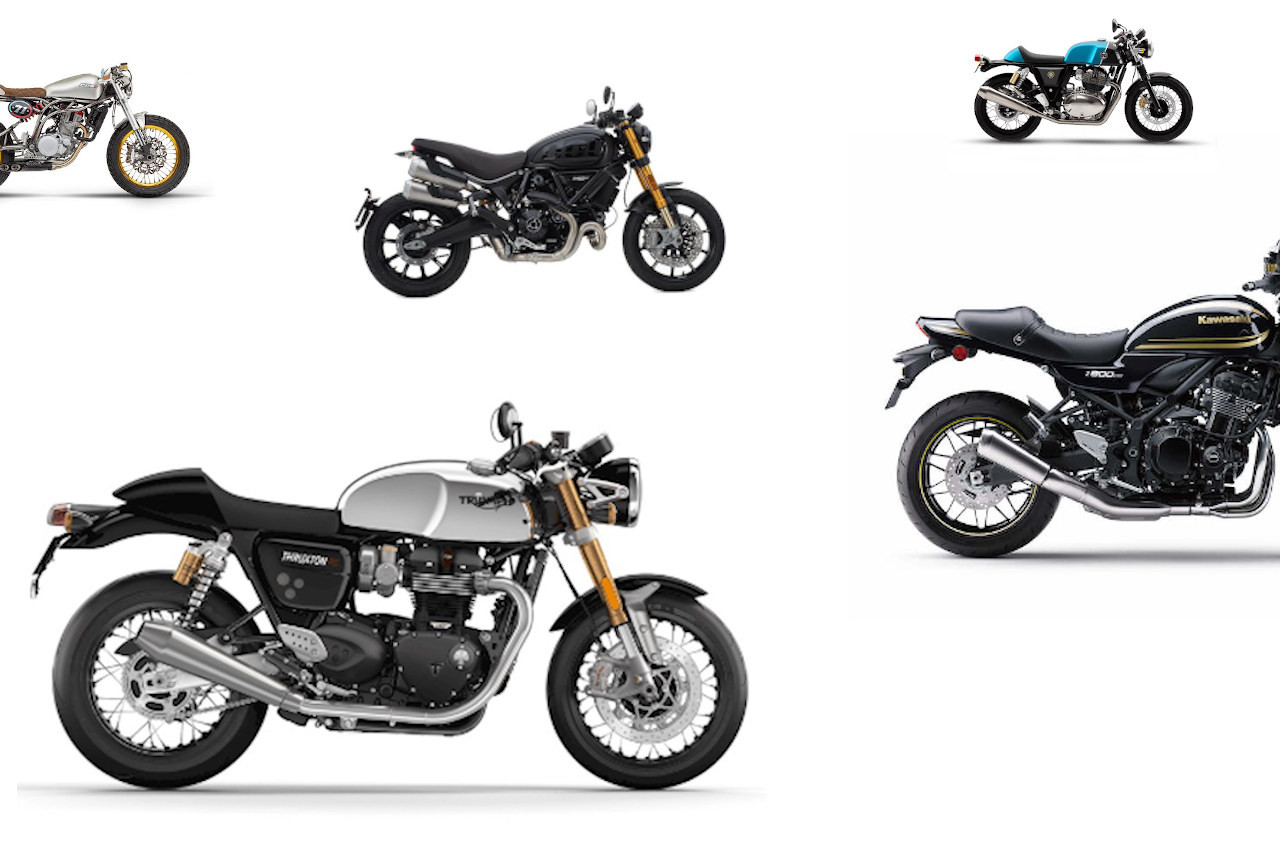 Best Modern Classic Cafe Racers
Best Modern Classic Cafe Racers
Considering the extensive coverage on this website, it might be surprising that this is our first dedicated list of cafe racer motorcycles. However, with a wealth of modern classic racers available in 2024, now feels like the perfect time to delve in.
In the list below, you’ll notice that we’ve focused exclusively on modern classic bikes, distinguishing them from neo-retro models. While the distinction exists, the lines can blur, particularly with bikes like the Scrambler Ducati and BMW R nineT.. We invite you to consider where these models truly belong.
 Thruxton 1200 R approaching Image: Chris P. Roberts
Thruxton 1200 R approaching Image: Chris P. Roberts
Our selection includes both new and used cafe bikes. The secondhand market is full of lightly-used options, often purchased by riders initially drawn to the stylish appeal of these cafe hoppers.
 Triumph Thruxton, Ton-Up Edition Outside the Ace Cafe London Image: Triumph Motorcycles
Triumph Thruxton, Ton-Up Edition Outside the Ace Cafe London Image: Triumph Motorcycles
1. Triumph Thruxton 1200 RS
 Triumph Thruxton RS Chrome Edition Image: Triumph Motorcycles
Triumph Thruxton RS Chrome Edition Image: Triumph Motorcycles
Leading our list is the Triumph Thruxton 1200 RS. Introduced in November 2019 and launched in 2020, it inherited the cafe racer mantle from the 2016 Thruxton 1200 R, becoming the flagship model in Triumph Motorcycles’ Modern Classic lineup. (The earlier R model did not receive a Euro 5 update.)
The Thruxton RS perfectly embodies modern-classic cafe bike design. Its silhouette echoes the iconic machines of the 1950s and 60s, refined for today’s tastes. If you envision factory-built street racers, this cafe bike is likely what comes to mind.
Powered by an updated Bonneville 1200 HP (High Power) 270º crank engine, the RS delivers 103 bhp at 4,250 RPM and 112Nm of torque at 4,250 rpm. This represents about a 6 bhp increase and enhanced torque compared to its predecessor, achieving peak power at 700 rpm lower. The R model was already quick off the mark, and the RS is no different.
This cafe bike is known for its torque, excellent cornering, and easy handling. However, unlike the original, hand-built cafe racers of the past, it carries some weight.
Triumph lists a dry weight of 197kg, though the wet weight is closer to 250 kg. Fortunately, the weight is positioned low, making it less noticeable once you’re in motion.
The Thruxton RS features high-end components and exquisite finishes, including brushed and polished aluminum. The throttle body (designed to resemble a carburetor), the top triple yoke, and the dual dials are particularly well-crafted.
The standard 2023 Thruxton RS is available in Jet Black or Competition Green & Silver Ice. Special editions include the Ton Up edition in Aegean Blue/Fusion White and the Chrome edition with a striking chrome tank.
In October 2023, Triumph introduced the Thruxton FE (Final Edition), marking the end of production for this revered model. Collectors seeking a piece of modern classic cafe bike history might gravitate towards the FE model.
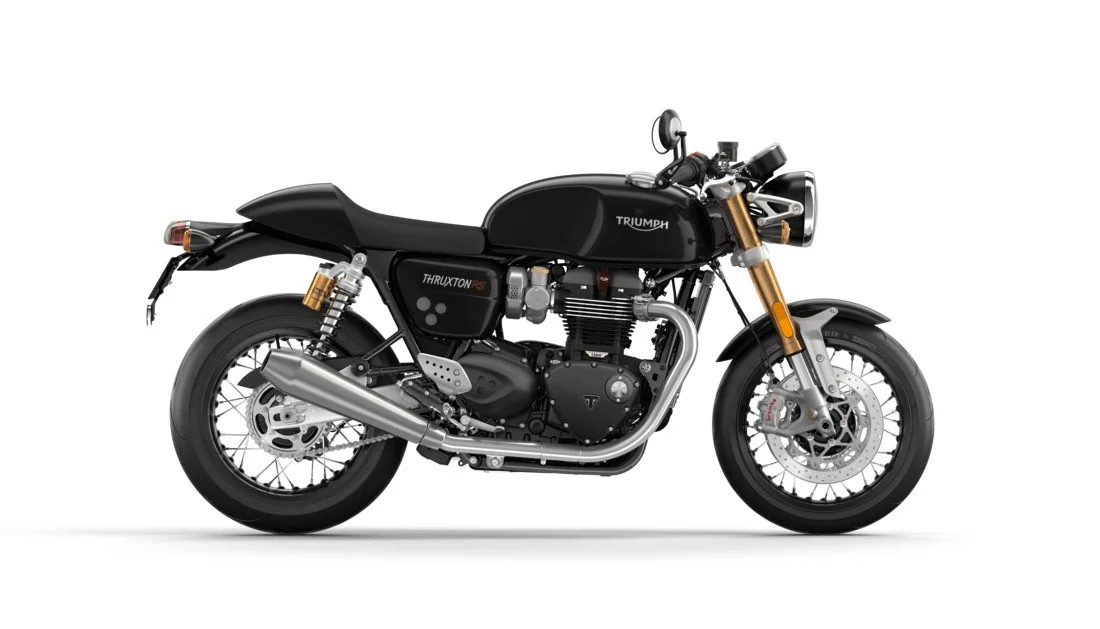 Triumph Thruxton RS Black Image: Triumph Motorcycles
Triumph Thruxton RS Black Image: Triumph Motorcycles
Triumph Thruxton 1200 RS Specifications at a Glance
- Engine: 1200cc liquid-cooled parallel twin
- Max Power: 105 PS/103 bhp (77 kW) @ 7,500 rpm
- Max Torque: 112Nm @ 4,250 rpm, 700 rpm lower than its predecessor
- Brakes: (Front) Twin 310 mm Brembo floating discs, Brembo M50 4-piston radial monobloc calipers, ABS and (Rear) Single 220 mm disc, Nissin 2-piston floating caliper, ABS
- Weight: 197 kg (Dry)
- Fuel Tank Capacity: 14.5 L
2. Yamaha XSR900 GP
 2024 Yamaha XSR900 Legend Red Image: Yamaha Motor Europe N.V.
2024 Yamaha XSR900 Legend Red Image: Yamaha Motor Europe N.V.
It would be incomplete to exclude Yamaha’s latest ‘Heritage’ model, the XSR 900 GP, from this cafe bikes list. This machine not only honors the Grand Prix era of the ’80s and early ’90s but also features Yamaha’s latest technological advancements.
Yamaha’s approach to retro cafe bikes has historically focused on the 70s and 80s through various iterations of its heritage lineup.
Their ‘Faster Sons’ philosophy demonstrates the brand’s willingness to take a modern approach to its retro models, seamlessly blending classic design elements with Yamaha’s contemporary engineering excellence.
Yamaha utilizes the same base platforms found in their contemporary-styled range, with retro modifications for the XSR125, XSR700, and XSR900 models. This could classify them as neo-retro rather than purely retro cafe bikes.
Introduced as part of the 2024 lineup, the XSR900 GP features a nostalgic, boxy, race-inspired cowling atop a thoroughly modern 890cc CP3 engine, all within an ultra-rigid Deltabox-style chassis. This cafe bike is no underperformer, generating 87.5 kW (117 bhp) of power at 10,000 rpm and 93.0 NM (68.6 ft-lb) of torque at 7,000 rpm.
What distinguishes the XSR 900 GP from some other cafe bikes on this list is its integration of modern comforts and technology. It includes cruise control, a quick shift system, and an A&S clutch.
Furthermore, it features an impressive tech suite, including a six-axis IMU providing lean-sensitive traction and slide control, along with a wheelie lift system. These features allow it to compete head-to-head with contemporary-styled bikes in its class.
If you’re drawn to the retro aesthetic of cafe bikes but are also a dedicated middleweight track enthusiast, this is the bike for you.
Available in the Marlboro Yamaha-inspired livery (Legend Red) or Power Grey, the XSR900 GP starts at £12,500 (or $15,800).
 2024 Yamaha XSR900 GP Power Grey Image: Yamaha Motor Europe N.V.
2024 Yamaha XSR900 GP Power Grey Image: Yamaha Motor Europe N.V.
Yamaha XSR900 GP Specifications at a Glance
- Engine: 890cc 4-stroke, Liquid-cooled, DOHC, 4-valves, 3-cylinder
- Max Power: 87.5 kW (119 PS) @ 10,000 rpm
- Max Torque: 93 Nm (9.5 kg-m) @ 7,000 rpm
- Brakes: (Front) Hydraulic dual disc brake, Ø 298 mm (Rear) Hydraulic single disc brake, Ø 245 mm
- Weight: 200 kg (Wet)
- Fuel Tank Capacity: 14 L
3. Royal Enfield Continental GT 650
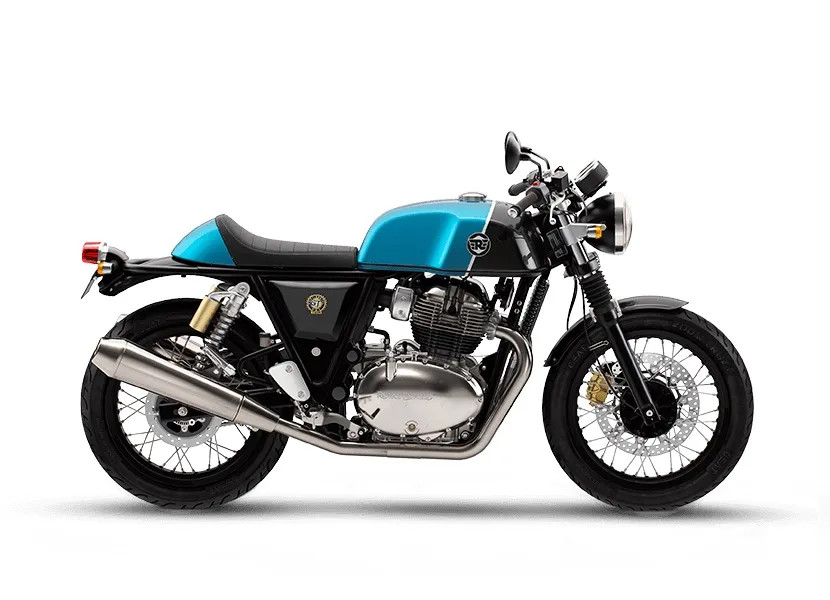 The Royal Enfield Continental GT650 in Ventura Storm, a cafe bike that delivers an authentic vintage riding experience. Image: Royal Enfield
The Royal Enfield Continental GT650 in Ventura Storm, a cafe bike that delivers an authentic vintage riding experience. Image: Royal Enfield
Launched by Royal Enfield in 2019, the Continental GT 650 offers a more genuinely vintage cafe bike experience compared to some others on this list. Its silhouette is distinctly retro, with sharp, straight lines throughout its profile, reminiscent of classic street racers.
While its looks are from the past, the GT650 is built on a modern, high-quality platform, albeit with less technology. RE refers to this uncluttered riding experience as “Pure Motorcycling.”
This translates to fewer electronic distractions for the rider. Conversely, it means the bike is comparatively less technologically advanced than others in this cafe bike category.
Like its roadster sibling, the Interceptor, the GT 650 is powered by a charismatic air-oil-cooled, SOHC, 648cc, parallel-twin engine. Within the Royal Enfield range, this middleweight cafe bike succeeded the less powerful Continental GT 535.
It boasts nearly double the power of its predecessor, producing 47 bhp (34.9 kW) at 7,150 rpm. This makes it ideal for younger riders in the UK and Europe, as it is A2 license compliant.
The GT 650, like many cafe bikes, is torquey and rev-happy. It delivers power smoothly across the rev range, peaking at 52.3 @ 5,150 rpm. The exhaust note is notably pleasing and memorable.
Designed after Royal Enfield acquired British frame designer Harris Performance Products, the GT 650 is known for its good handling.
Braking is provided by single discs at the front and rear, 320mm and 240mm respectively. The brakes are effective without being overly aggressive, which is beneficial for newer riders who might accidentally over-apply the front brake. ABS further enhances safety.
Available in five color schemes, this cafe bike is perfect for riders who fully appreciate classic style and those seeking a beginner-friendly, larger displacement motorcycle experience.
 Royal Enfield Continental GT 650 Mr Clean Image: Royal Enfield
Royal Enfield Continental GT 650 Mr Clean Image: Royal Enfield
Royal Enfield Interceptor Specifications at a Glance
- Engine: 648cc, parallel-twin
- Max Power: 34.9 kW @7150 rpm (Kw/HP-rpm)
- Max Torque: 52.3 Nm @5150 rpm
- Brakes: ByBre320 mm disc, ABS (Front) – 240 mm disc, ABS (Rear)
- Weight: 212 kg (Wet)
- Fuel Tank Capacity: 12.5 litres
4. BMW R NineT Racer S
 BMW R nineT Racer 2017 to 2019 – right profile Image: BMW Motorrad
BMW R nineT Racer 2017 to 2019 – right profile Image: BMW Motorrad
BMW created the R nineT to celebrate the 90th anniversary of their air-cooled Boxer-twin engine. The platform has since been updated for their centennial, with the R 12 nineT released in late 2023.
The original R nineT, conceived during Ola Stenegärd’s tenure as head designer and a custom bike enthusiast, marked a departure from BMW’s typically progressive product design.
Upon its launch, the R 9T spearheaded BMW’s heritage line and felt somewhat experimental at the time, as the retro segment was not as established as it is today.
The experiment proved successful. BMW expanded the platform with variants like the Pure, Scrambler, Urban G/S, Racer, and Racer S. The latter is included in this cafe bikes list, though with a note of caution. (The image shown is of the standard Racer; the Racer S features wire-spoked wheels.)
While a competent machine, the Racer’s stretched-out riding position impacted sales. Consequently, the Racer was only in production for about 1.5 years (2017-2019) before being discontinued. It was notably absent when the R nineT range received a Euro5 update in 2020.
Under Stenegärd’s influence, the R nineT platform was designed for customization, evident in its easily removable subframe. Numerous aftermarket parts are available for even novice enthusiasts to personalize their Beemer cafe bike.
Considering the Racer’s aggressive riding posture, installing riser clip-ons can significantly improve comfort. If you’re comfortable with modifications, the secondhand market is the place to find an R 9T Racer S. You can likely find a good deal on eBay or similar platforms.
If a Racer is unavailable secondhand and budget allows, a new R nineT Roadster is a viable alternative. With swan-neck clip-ons and a seat cowl, a stronger cafe racer aesthetic can be achieved, along with a more relaxed riding position and better equipment.
Interestingly, the original Roadster came with superior suspension compared to the Racer, featuring fully adjustable inverted forks as standard, while the Racer traditionally used telescopic forks.
The standard Racer was essentially a Pure model with a half-fairing. Both the older Roadster and Racer share the same power output: 110bhp (81kW) @ 7550rpm and 88 lb-ft (119Nm) @ 6000rpm.
With the Euro5 update, the newer model loses 1 hp but achieves peak power at a lower 7250 rpm.
Apart from a few limited edition colors, the R nineT Racer is primarily found in the BMW Motorsport color scheme.
 BMW R nineT Racer 2017 to 2019 – left profile Image: BMW Motorrad
BMW R nineT Racer 2017 to 2019 – left profile Image: BMW Motorrad
BMW R nineT Specifications at a Glance
- Engine: Air-cooled, Boxer twin
- Max Power: 110bhp (81kW) @ 7550rpm
- Max Torque: 88 lb-ft (119Nm) @ 6000rpm
- Brakes: (F) 2 x 320mm discs, four-piston caliper and (R) 265mm disc, two-piston calipers (Brembo)
- Weight: 220 kg (Wet)
- Fuel Tank Capacity: 17 Litres
5. Kawasaki Z900RS Cafe MY2020 UK or MY2023 US
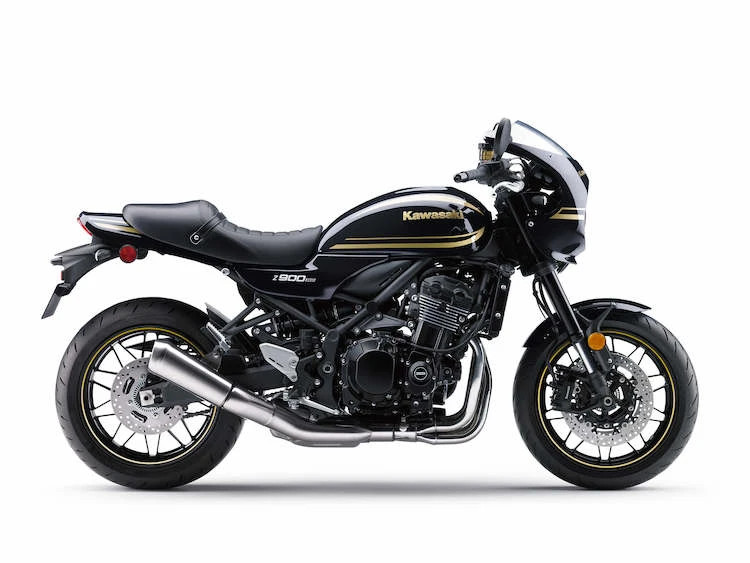 Kawasaki Z900 RS Cafe UK & EU MY2023 Version Image: Kawasaki
Kawasaki Z900 RS Cafe UK & EU MY2023 Version Image: Kawasaki
Kawasaki’s entry into the retro motorcycle segment was highly anticipated and enthusiastically received. Instead of creating an entirely new platform, they utilized the proven Z900 platform to develop the Z900 RS and the Z900 RS Cafe, the latter featured here. Some adjustments were made to the torque and power curves to better suit the cafe bike style.
As a result, the liquid-cooled Z900 RS is a capable machine that can compete with any contemporary bike in its class. This cafe bike produces 82 kW {111 PS} at 8,500 rpm and 98.5 N•m at 6,500 rpm, placing it performance-wise alongside top retro rivals like the Thruxton RS and BMW R nineT.
With a design inspired by the iconic Z1 model of the 70s, the Z900RS was instantly popular with the motorcycle press and riders. Subsequent reviews have been overwhelmingly positive.
The bike features the distinctive duckbill tail end of the original Z1. However, Kawasaki intentionally prioritized function over pure aesthetics in other areas.
The Z900 RS opts for a modern mono-shock setup instead of twin shocks. Notably, the exhaust configuration is a 4-into-1 rather than the original double-sided twin exhaust of the 70s Zed.
In the UK/Europe, the RS Café is absent from Kawasaki’s current modern classic range. The closest model in terms of specification is the Z900 RS SE. While it includes most of the equipment expected on a modern classic racer, its stance and handlebars are more aligned with an assertive roadster than a dedicated street racer cafe bike.
However, North American markets do offer an updated Cafe model (pictured below).
Versions of the RS Cafe for each market include a front cowl, lower clip-on handlebars, and a single racer seat with a more pronounced rear lip, enhancing its single-seater cafe bike appeal. The UK version is finished in Vintage Lime Green & Ebony, while the North American market gets a metallic black finish with gold stripes.
If you can find a used MY2020 RS Cafe model, you’ll experience similar performance to the current lineup. You might find a 2020 model with relatively low mileage on eBay for around £9,000 in the UK.
![Kawasaki Z900 RS Cafe lhs [EU & UK]](https://usabikers.net/wp-content/uploads/2025/03/kawasaki-z900-rs-cafe-lhs.jpg) Kawasaki Z900 RS Cafe lhs [EU & UK] Image: Kawasaki
Kawasaki Z900 RS Cafe lhs [EU & UK] Image: Kawasaki
Kawasaki Z900 RS Café MY2020 Specifications at a Glance
- Engine: 948 cc liquid-cooled, 4-stroke In-Line Four
- Max Power: 82 kW {111 PS} / 8,500 rpm
- Max Torque: 98.5 N•m {10 kgf•m} / 6,500 rpm
- Brakes: (Front) Dual semi-floating 300 mm discs. Caliper: Dual radial-mount, monobloc, opposed 4-piston + (Rear) Single 250 mm disc. Caliper: Single-piston
- Weight: 216 kg
- Fuel Tank Capacity: 17 litres
6. Norton Commando 961CR
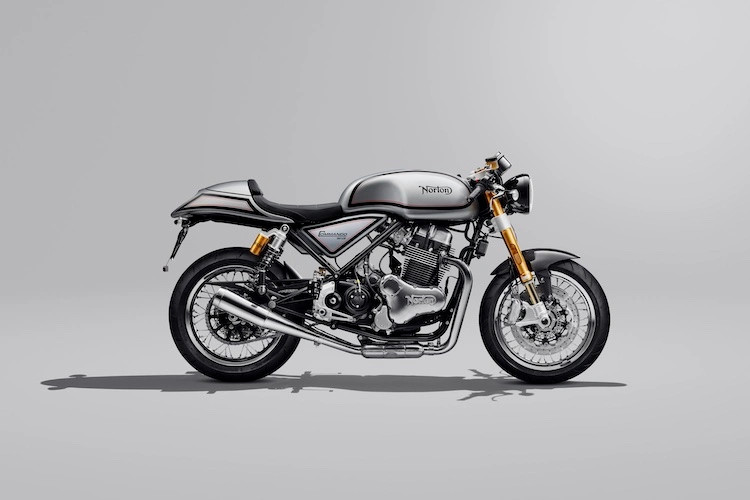 Norton Commando 961 Café Racer Silver Image: Norton Motorcycles
Norton Commando 961 Café Racer Silver Image: Norton Motorcycles
Just in time for this list is the new Norton Commando 961, released in 2023. The model lineup includes two variants: the SR (Standard Roadster) and CR (Café Racer).
TVS acquired Norton in April 2020 after the previous company’s collapse. Since then, they have been diligently working to resolve issues with the inherited model range and rebuild brand trust by fulfilling existing orders.
The Commando 961 range is the first to emerge from Norton’s new, modern facility in Solihull, West Midlands, England.
While it strongly resembles the previous model, Norton states that over a third of the bike has been redesigned and rebuilt. Early reviews are positive, highlighting handling and sound as key strengths of this cafe bike.
Performance figures are where it slightly lags. The Commando reaches a peak power of 76.8 bhp at 7,250 RPM. However, it offers respectable torque with 81Nm at 6300rpm.
Despite its higher price point, the Commando 961 CR isn’t as powerful as the Triumph Thruxton RS, its historical rival. It also isn’t the fastest in this group. In terms of performance, it sits between the quickest and slowest cafe bikes on this list.
However, the Norton may surpass its competitors in prestige and exceptional build quality. This is significant, considering the universally high standards of its rivals.
Anodized billet aluminum and carbon fiber, combined with meticulous attention to detail in the hand-built 961 CR, are paired with top-tier components: Ohlins forks and shocks, a full Brembo braking system, and aluminum clip-ons.
Reviews of both models have been favorable. Both are offered in two color options: Matrix Black and Manx Platinum.
 Norton Commando 961 Cafe Racer Black – lhs Image: Norton Motorcycles
Norton Commando 961 Cafe Racer Black – lhs Image: Norton Motorcycles
Norton Commando 961 CR Specifications at a Glance
- Engine: 961cc, Four-valve, pushrod, air-cooled parallel twin
- Max Power: 76.8 bhp @ 7,250 RPM
- Max Torque: 81 Nm (59.7 ft-lb) @ 6,300 RPM
- Brakes: 2 x 320mm discs with four-piston calipers. ABS and 240mm disc, one-piston caliper
- Weight: 230kg
- Fuel Tank Capacity: 15 litres
7. Ducati SportClassic – Sport 1000 S
 Ducati SportClassic Sport 1000 S Red Image: Ducati Motor Holding S.p.A
Ducati SportClassic Sport 1000 S Red Image: Ducati Motor Holding S.p.A
Ducati’s SportClassic range was conceived by former head designer Pierre Terblanche. The Sport1000, GT1000, and Paul Smart limited edition concepts debuted at the Tokyo Motor Show in 2003. The Paul Smart edition specifically honored short-circuit racing legend Paul Smart and his Imola 200 GP-winning bike.
All models were universally admired, leading Ducati to announce in 2005 that sales of the range would begin in spring 2006. The SportClassic became the early benchmark in the modern-classic factory cafe bike segment.
Featuring a 992cc L-twin engine, the SportClassic design aimed to evoke the cafe racer style of the 50s and 60s, particularly drawing inspiration from the 1974 Ducati 750 Super Sport ‘Imola’ (based on Paul Smart’s 750 race bike). It also incorporated styling cues from the MH900e, also designed by Terblanche.
The 750 SS is likely a dream bike for many classic bike enthusiasts. (A solid foundation for a modern classic cafe bike.)
With its contemporary, torquey, air-cooled 90º Desmo 1000 Dual Spark engine, the SportClassic range was both modern and classic—a relatively new concept in motorcycle innovation at the time.
Looking back, Ducati created a machine ahead of its time. Its only competitors were the asthmatic air-cooled Thruxton 900 and the similarly breathless Kawasaki W650. However, initial real-world road tests of the SportClassic range received widespread criticism, primarily focused on the extremely stretched-out riding position.
Ducati responded by releasing the upright GT1000 with a shorter fuel tank in 2007 (to reduce reach to the handlebars), along with the Sport 1000 S featured here. The 1000 Biposto [single seat] followed in 2008 with raised clip-ons. Despite these improvements, the initial negative impressions lingered, and sales remained low. The line was discontinued in 2010.
Ducati didn’t even wait to see the results of its significant product placement in the Tron Legacy movie. (The protagonist… (spoilers ahead) rides the Biposto version in the opening action sequence and end scene of Disney’s sequel).
Combined with its stunning looks and rarity, the SportClassic is now a collector’s cafe bike. Initially priced around £7,500 in 2006, expect to pay upwards of £15,000 for the Sport 1000S and as much as £30,000 for the limited edition Paul Smart.
 Ducati SportClassic Sport 1000 S Black Image: Ducati Motor Holding S.p.A
Ducati SportClassic Sport 1000 S Black Image: Ducati Motor Holding S.p.A
Ducati SportClassic – Sport 1000S Specifications at a Glance
- Engine: 992 cc, L-twin cylinder, 2 valves per cylinder Desmodromic; air-cooled
- Max Power: 67.7 kw – 92 hp @ 8000 rpm
- Max Torque: 67.3 lb-ft – 9.3 kgm @ 6000 rpm
- Brakes: (Front)2x320mmsemi-floating discs,2-piston,2-sintered pad floating caliper – (Rear) 245 mm disc, 1-piston floating caliper
- Weight: 179 kg
- Fuel Tank Capacity: 15 litres
8. Moto Guzzi V7 Racer III MY20
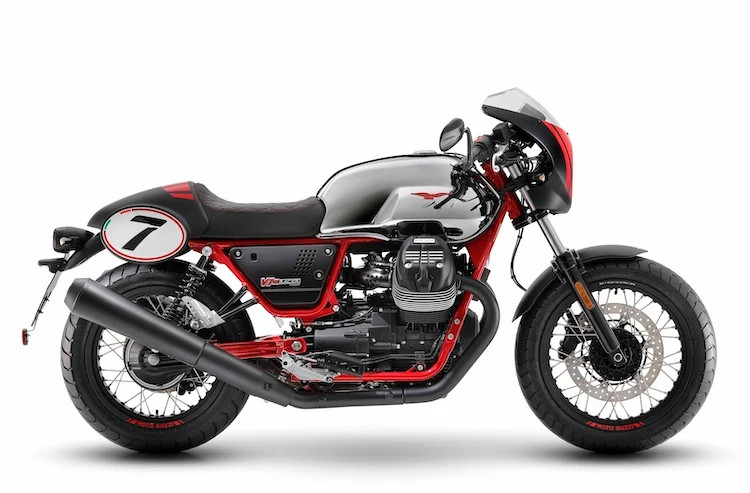 Moto Guzzi V7III Racer 10th Anniversary Cafe Racer Image: Moto Guzzi
Moto Guzzi V7III Racer 10th Anniversary Cafe Racer Image: Moto Guzzi
Moto Guzzi’s current V7 range takes its name from the original V7 motorcycle first manufactured in 1967. Relaunched in 2010, the range has evolved through three iterations and now features its most powerful engine yet.
The V7 Racer featured here is the 10th Anniversary edition, launched in 2019 for MY20. It could be argued that it’s styled after the 1971 V7 Sport, but without the lime green, perhaps it’s more stylistically similar in ethos than pure aesthetic. It’s essentially a sportier version of the V7 Roadster. However, the Rosso Corsa frame and swing arm do echo the telaio rosso (red frame) of the 70s Sport, reinforcing its cafe bike heritage.
With its shaft drive, distinctive fuel tank, and unique transverse 750cc v-twin engine, the Moto Guzzi V7 is instantly recognizable and beloved. The Racer model is more refined than the standard V7 Stone, notably featuring black anodized aluminum extensively throughout the bike, adding to its cafe bike appeal.
Despite its “Racer” moniker, outright speed isn’t its primary focus. The V7 Racer sits at the more relaxed end of the cafe bike segment. With 52 hp at 6200 rpm and 60 Nm at 4900 rpm, it, like the Royal Enfield GT Continental and W800, is well-suited for beginners looking for a stylish cafe bike.
Regardless, the bar-end mirrors and bikini fairing with windshield give this Moto Guzzi a purposeful and stylish look.
 Moto Guzzi V7 MKIII Racer 10th Anniversary LHS Image: Moto Guzzi
Moto Guzzi V7 MKIII Racer 10th Anniversary LHS Image: Moto Guzzi
Moto Guzzi V7 Racer III Specifications at a Glance
- Engine: 744cc, air-cooled v-twin
- Max Power: 38 kW / 52 hp @ 6200 rpm
- Max Torque: 60 Nm / 44.2 lb-ft @ 4900 rpm
- Brakes: Single 320mm disc with 2 piston caliper – (Rear) Single 260mm disc with 2piston caliper
- Weight: 193kg (Wet)
- Fuel Tank Capacity: 21-litre
9. Scrambler Ducati 1100 Sport Pro
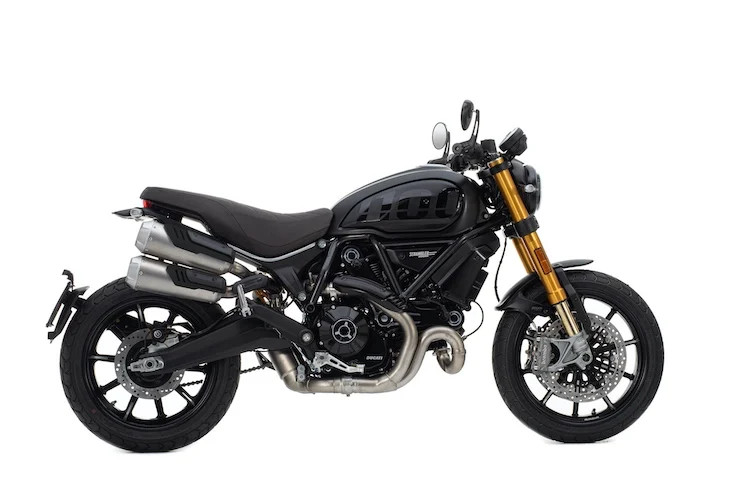 Ducati Scrambler 1100 Sport Pro Image: Scrambler Ducati
Ducati Scrambler 1100 Sport Pro Image: Scrambler Ducati
Next on our cafe bikes list is another Ducati. Ducati’s success in the last decade is closely linked to the launch of its Scrambler range through a dedicated subsidiary.
Scrambler Ducati has consistently produced street scramblers and a capable off-roader, the Desert Sled, all of which have been popular with riders, contributing significantly to Ducati’s success.
A decade after the SportClassic’s launch, Ducati hesitated to revive the model line, despite the growing number of riders drawn to retro bikes. Instead, they launched the Scrambler in 2015, loosely based on their 70s model of the same name.
Ducati’s Scrambler 1100 Sport Pro, released in 2018/19 and updated in 2020/21, functions very much like a cafe racer, making its “Scrambler” name somewhat of a misnomer.
This is less contradictory than the previously named Scrambler Ducati Cafe Racer, which was part of the 800 Scrambler range but has since been replaced by the Scrambler Nightshift.
Returning to the 1100 Sport Pro, with its matte-black finish and contrasting brown leather seat, it heavily borrows from new-wave custom style. Ducati’s Custom Rumble competition had showcased similar designs before the Sport 1100’s launch.
Aesthetics aside, this 1048cc oil-air-cooled, two-valve L-twin Ducati delivers 86 hp (63 kW) at 7,500 rpm and 65 lb-ft (88 Nm) @ 4,750 rpm, providing ample power for a cafe bike experience.
It is also equipped with high-end components, including fully adjustable Ohlins forks and preload and rebound adjustable springs on the rear, partly justifying its higher price of £14,495.
Despite the juxtaposition of name and genre, it remains a visually striking bike, even if it doesn’t strictly adhere to the typical cafe racer look.
 Ducati Scrambler 1100 Sport Pro lhs Image: Scrambler Ducati
Ducati Scrambler 1100 Sport Pro lhs Image: Scrambler Ducati
Scrambler Ducati 1100 Sport Pro Specifications at a Glance
- Engine: L-Twin, Desmodromic distribution, 2 valves per cylinder, air-cooled
- Max Power: 86 hp (63 kW) 7,500 rpm/min
- Max Torque: 65 lb-ft (88 Nm) @ 4,750 rpm
- Brakes: (F) 2 x Ø320 mm semi-floating discs and (R) Ø245 mm disc, 1-piston floating calliper Brembo
- Weight: 206 kg (wet)
- Fuel Tank Capacity: 15 litres
10. CCM Spitfire Café Racer
 CCM Spitfire Cafe Racer Image: Clews Competition Motorcycles
CCM Spitfire Cafe Racer Image: Clews Competition Motorcycles
Only 250 CCM Spitfire Café Racers were ever manufactured, making this lightweight, single-cylinder interpretation exceptionally rare. While ownership may be unlikely, this cafe bike deserves inclusion on this list due to its celebrated status.
The Bolton, England-based manufacturer, Clews Competition Motorcycles (CCM), founded in 1971 by former trials rider Alan Clews, is best known for building lightweight off-road motorcycles and competing in FIM Motocross.
Throughout its history, CCM has used modified BSA engines, as well as Rotax, Suzuki, and Kymco units.
See Also
Kawasaki Z650RS: All-New Modern-Classic, Middleweight Contender
Hand-built by CCM in 2019, the Spitfire line marked a departure from the British marque’s off-road focus. With its smoothly curved tubular steel trellis frame, the Spitfire Café Racer presents a unique take on the cafe bike genre.
It was particularly well-received by custom motorcycle enthusiasts during its display at The Bike Shed, London, largely due to its exquisite finish.
This cafe bike simultaneously breaks convention while still channeling heritage design. The brown diamond-stitched single seat and gold spoked wheels are prime examples of this blend.
Powered by a liquid-cooled, 4-valve Husqvarna 600cc single, it achieves a peak power of 55 bhp and 58 Nm of torque at 5,500 RPM.
The combination of its single cylinder and custom hand-welded exhausts gives the CCM a distinctive, deep burble. Weighing just 142kg (dry) ensures a nimble ride for cafe hopping.
At the time of writing, bike 131 of 250 is available through CCM’s Approved Bike program.
Originally priced at £9,274.00, you might find a pre-owned Spitfire for slightly more now. This value retention strongly suggests its potential as a future classic cafe bike.
 CCM Spitfire fuel tank with stripes Image: Clews Competition Motorcycles
CCM Spitfire fuel tank with stripes Image: Clews Competition Motorcycles
CCM Spitfire Café Racer Specifications at a Glance
- Engine: 600cc Single cylinder, Four-stroke
- Max Power: 58 BHP (0.41 HP/kg)
- Max Torque: 58 Nm @ 5,500 RPM
- Brakes: Single 320 mm Disc Front and 240 mm Disc Rear
- Weight: 142kg (Dry)
- Fuel Tank Capacity: 14 litres
11. Kawasaki W800 Cafe
 Kawasaki W800 Cafe rhs Image: Kawasaki
Kawasaki W800 Cafe rhs Image: Kawasaki
Another Kawasaki appears on this list, though at the opposite end of the power spectrum. While the Z900RS is a modern bike with retro styling, the W800 Cafe is a more classically oriented machine with modern features.
Originally produced from 2011 to 2016 and reintroduced in 2019, Kawasaki’s W800 line is the successor to the W650. The W650 is often considered the first bike to be categorized as retro.
Launched shortly before the resurgence of the Bloor-era Bonneville, it was built from 1999 to 2007. (Though Moto Guzzi might contend they never stopped producing retro bikes.)
Regardless, Kawasaki was ahead of other motorcycle manufacturers in this retro revival. However, the original sixties W model was more of a follower than a leader, taking inspiration from British parallel twins by BSA and Triumph. The design of the current W800 lineup still reflects this heritage.
In many ways, the W800 Cafe is more akin to a British twin from the past than Triumph’s original modern classic range.
This old-school machine more closely embodies the minimalist aesthetics of the era it emulates and will appeal to true retronauts seeking an authentic cafe bike experience.
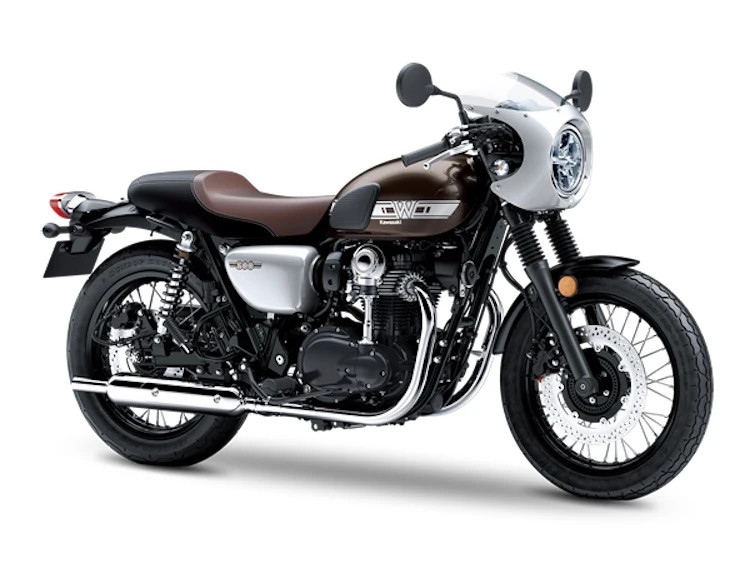 Kawasaki W800 Cafe Image: Kawasaki
Kawasaki W800 Cafe Image: Kawasaki
Kawasaki W800 Cafe Specifications at a Glance
- Engine: Air-cooled, 4-stroke Vertical Twin
- Max Power: 35 kW {48 PS} / 6,000 rpm
- Max Torque: 62.9 N•m {6.4 kgf•m} / 4,800 rpm and Single 270 mm disc. Caliper: Twin-piston
- Brakes: Single 320 mm disc. Caliper: Twin-piston
- Weight: 223 kg
- Fuel Tank Capacity: 15 Litres
Editor’s Picks: Which Modern Classic Cafe Bike?
If you share my enthusiasm for modern classic style, owning any of the bikes on this list would be a pleasure. As a Thruxton 1200 R rider, my bias is clear regarding which of these cafe bikes I’d choose (spoiler: it’s the Thruxton).
However, the BMW R nineT Racer was a close contender when I test-rode both.
The TTR won me over due to its full embrace of the modern classic ethos, despite the R NineT offering more power.
 Thruxton 1200 R riding into the sunset Image: Chris P. Roberts
Thruxton 1200 R riding into the sunset Image: Chris P. Roberts
Yet, I often question my decision whenever I’m next to a Beemer at traffic lights—admiring its profile, enjoying its deep, burbling idle, and then deliberately hanging back to savor the sound as it accelerates away.
If rarity wasn’t a factor, the Ducati SportClassic would be my choice for its iconic style as a cafe bike.
Alternatively, if value and a strict adherence to the sixties silhouette were priorities, the Royal Enfield would be the winner.
But for sheer uniqueness, the CCM Café Racer takes the crown. Ultimately, the best choice often comes down to a test ride, but each of these cafe bikes has the potential to win you over regardless.
Cafe Racer Motorcycle: Overview & Origins
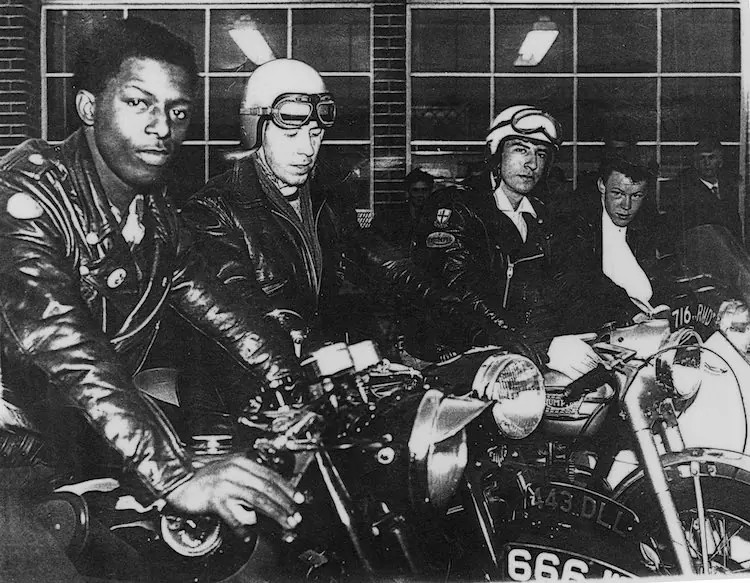 59 Motorcycle Club Members Image: 59 Club
59 Motorcycle Club Members Image: 59 Club
In 2024, the term “cafe racer” is used quite liberally. Browse any insurance broker’s blog today, and you’ll find lists of “cafe racers” populated with very upright, standard roadsters, or bikes that only superficially resemble retro/modern classic motorcycles, barely nodding to classic styling.
So, what does “cafe racer” actually mean? What is a cafe bike?
In short, without a lengthy history lesson, cafe racers are standard street motorcycles customized by riders, primarily in 1950s and 60s Britain, for speed. They were typically home or shed-built, single-seat street racers that have experienced a resurgence with the rise of new-wave custom culture and the popularity of cafe bikes.
What defines a motorcycle as a cafe racer?
Originally, they were characterized by a stripped-down aesthetic, straight profile lines, drop bars, and single seats with a cowl. The 21st-century definition remains largely the same, although modern-classic, factory-produced cafe bikes are rarely as stripped-back as their original, home-built predecessors.
The original cafe racers often used Triumph, BSA, Norton, Royal Enfield, or AJS motorcycles as a base and were almost always fitted with clubman or clip-on bars. In the late 60s, some riders began to favor newer, more powerful Japanese bikes as cafe bike platforms.
However, perhaps the most iconic of all such bikes is the Triton, which combined the featherbed frame of a Norton with a powerful parallel-twin engine from Triumph, representing the pinnacle of early cafe bike engineering.
Why are they called cafe racers?
These shed-built bikes were frequently raced between transport cafes, making the name almost inevitable. Back then, in British English, it was often pronounced caff racer—because correctly pronouncing French words was considered pretentious.
1950s to late 60s: Ton-up Boys & Rockers
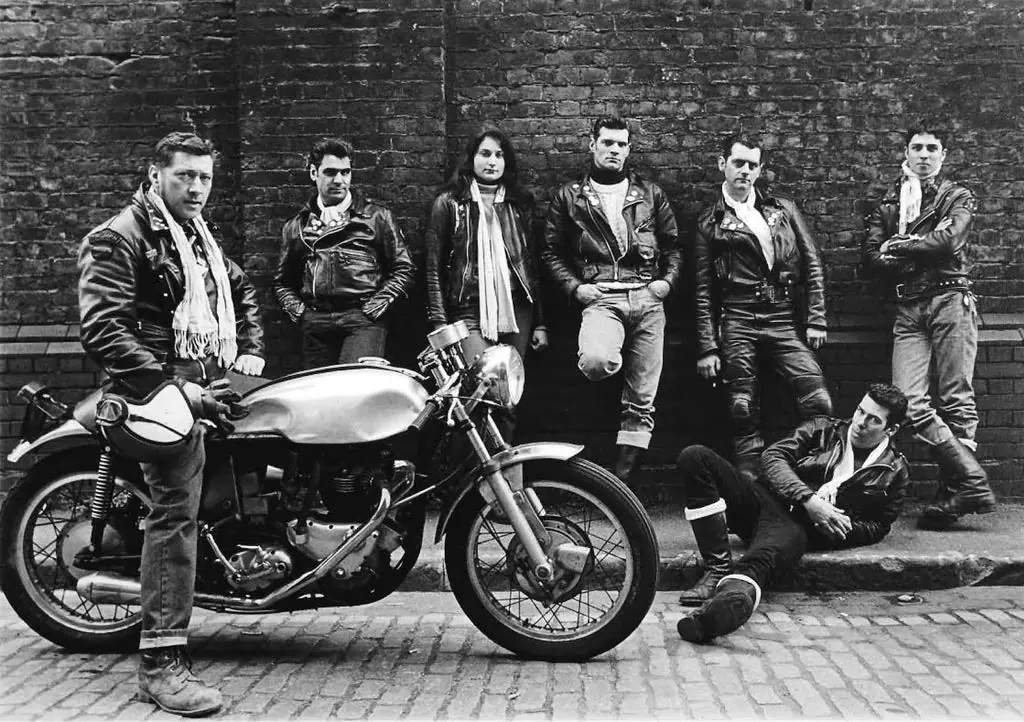 ‘Or Glory: 21st Century Rockers’, depicting the rebellious spirit of the Ton-up Boys, central to cafe bike culture. Image: Horst A Friedrichs
‘Or Glory: 21st Century Rockers’, depicting the rebellious spirit of the Ton-up Boys, central to cafe bike culture. Image: Horst A Friedrichs
The group most associated with this motorcycle genre was the anti-establishment Ton-up Boys (later known as Rockers). They were inspired by RAF pilot style, American movies, music, and films like The Wild One (though banned in Britain until 1968). Despite the ban, stories and stills crossed the Atlantic, influencing the gear worn by these new rebels and cafe bike riders.
Beyond modifying their cafe bikes, Ton-up Boys were known for their Brylcreem, rock ‘n’ roll, leather jackets, aiming for “the ton” (100 MPH), and occasional clashes with Mods.
New Wave Customs
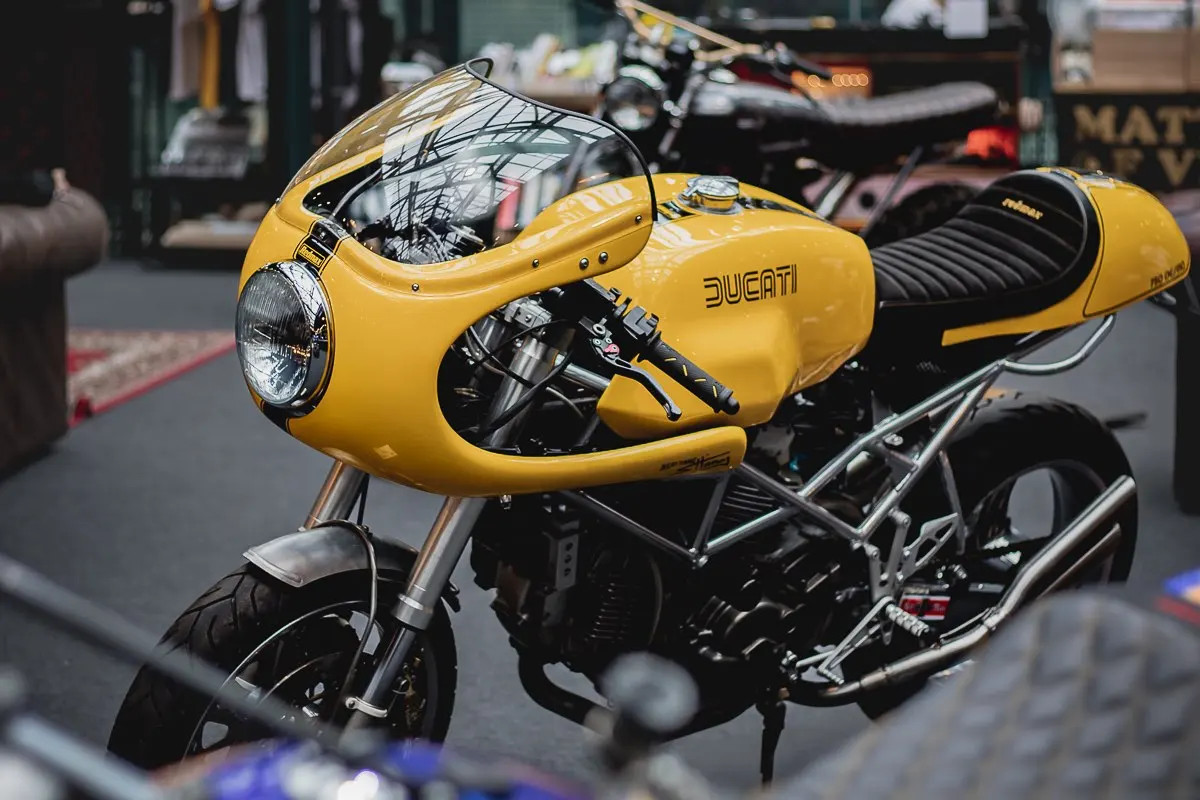 New Wave Custom Ducati on Display at the Bike Shed Show Image: @motophotonate
New Wave Custom Ducati on Display at the Bike Shed Show Image: @motophotonate
In the 21st century, cafe racers are recognized globally, but the term has evolved. Motorcycle manufacturers now produce them as factory models.
Some manufacturers stay true to the original genre, while others offer their own contemporary interpretations of cafe bikes. Regardless, all manufacturers owe inspiration to new-wave custom bike builders.
 Moto Guzzi Cafe Racer – Custom Top Yoke
Moto Guzzi Cafe Racer – Custom Top Yoke
Some argue that cafe racers should be built, not bought. Furthermore, major manufacturers have been accused of co-opting a subculture (Kustom culture) to boost bike and merchandise sales. Others believe manufacturers are simply responding to market demand and customer preferences for cafe bikes.
The reality is likely a blend of both. In any case, the relationship between manufacturers and custom motorcycle builders has always been symbiotic.
Manufacturers: Modern Production Cafe Racers
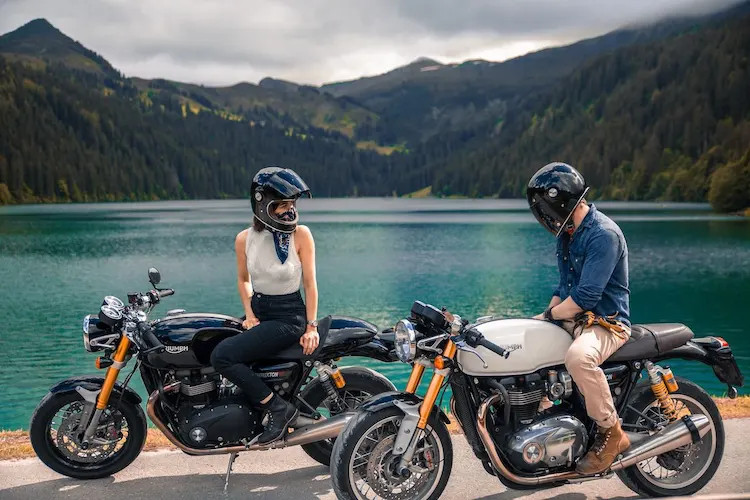 Modern Classic Triumph Thruxton RS and R | Duncan Adler Image: Duncan Adler
Modern Classic Triumph Thruxton RS and R | Duncan Adler Image: Duncan Adler
Manufacturers have continuously released innovative motorcycles that eventually develop into distinct genres. Bike builders then adapt and refine these bikes, generating new ideas for manufacturers, who in turn release new models. Builders then customize these new bikes, inspiring further manufacturer designs and styles—a continuous cycle.
Several manufacturers host annual competitions or run programs to encourage further customization of their neo-classic ranges, particularly within the cafe bike sphere.
Ducati has its Custom Rumble competition, and Yamaha has the Yard Built program. In recent years, Triumph dealers have even competed in custom build shootouts.
This is a cost-effective way to gauge styling and design trends and test potential customer preferences, especially in the evolving cafe bike market. This approach has driven the evolution of neo-retro motorcycles over the past decade.
Modern factory cafe racers were initially arguably designed to generate additional revenue through nostalgia marketing. With one exception (the Ducati SportClassic), the first cafe bikes released in this genre often struggled to compete with fully modern equivalents. Nonetheless, riders purchased them in significant numbers but soon demanded more. Manufacturers responded.
Today, numerous retro bikes in production pack as much punch (sometimes more) as their contemporary counterparts. These cafe bikes may look like they belong to a bygone era and should be slower, but they often aren’t.
Modern Classic vs Neo-Retro
 Retro Riders Cafe Racers by Gijs Coolen Image: Gijs Coolen
Retro Riders Cafe Racers by Gijs Coolen Image: Gijs Coolen
It’s crucial to distinguish between modern-classic and neo-retro motorcycles, especially when discussing cafe bikes. These terms represent two distinct sub-genres within the retro motorcycle segment.
Modern-classic motorcycle models meticulously emulate the design aesthetics of the past. From a distance, these machines can be mistaken for historic models. These bikes typically have a clear lineage to a manufacturer’s past models, either through name or design emulation. The entire Triumph Motorcycles Bonneville range perfectly illustrates modern-classic motorcycle design and cafe bike styling.
Neo-retro motorcycles, conversely, are contemporary in design.
However, their form incorporates some aspects of classic motorcycle design, such as a half-front fairing, a single round headlight, or subtle classic design cues in the bike’s lines. Typically, the design of these bikes takes a more progressive approach to the genre, appealing to riders who appreciate cafe bikes with modern touches.
An excellent example of a neo-retro motorcycle is the MV Agusta Superveloce 800.
If you are a younger rider or seeking a more relaxed bike within the same genre, explore our list of the best 125 cafe racers, offering accessible entry points into the world of cafe bikes.

